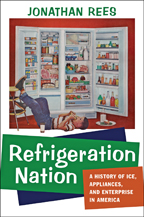“Tell me what you eat, and I will tell you what you are.”
– Jean Anthelme Brillat-Savarin, The Physiology of Taste, 1825.
The great problem I have maintaining my Twitter account is to keep the edtech people happy when I share too much history, and the history people happy when I share too much edtech. This feels like a particularly acute problem when I’m on a food history kick, as the number of refrigeration nerds amongst my tweeps is really pretty low. Luckily, I think I found away to kill two birds with one stone here. All it requires is a metaphor that’s been at the back of mind for a long time, but I’m going to use it now because it doesn’t really seem all that forced to me anymore.
There’s an article in this week’s New Yorker (not behind the subscription curtain even!) that I find absolutely disgusting, in both the conventional and abstract sense of that word. Apparently, there’s a new startup called Soylent (Yes, like the movie*) that purports to offer you all the vitamins and minerals that you need to survive. Of course the idea started in Silicon Valley, and of course the stuff tastes absolutely repulsive:
People tend to find the taste of Soylent to be familiar: the predominant sensation is one of doughiness. The liquid is smooth but grainy in your mouth, and it has a yeasty, comforting blandness about it. I’ve heard tasters compare it to Cream of Wheat, and “my grandpa’s Metamucil.”
So why buy it? Allegedly, people are spending far too much time growing and eating food:
We pulled up at Caltech in early evening and were met by Rachel Galimidi, a Ph.D. candidate in biology, who is the resident adviser for Ricketts dorm. Galimidi said that the dorm is home to “a lot of very busy engineering and physics students” who “don’t have time to do anything”—including eat.
If this counts as lifehacking, then count me out. Eating is supposed to be one of the most pleasurable things in life. It’s freighted with both cultural value and priceless human experiences. Whatever benefits you might get from reducing it to a doughy liquid simply aren’t worth the costs.
While you may not see the parallel between this and the famous scene from “Modern Times” I posted above, I do think there is a similarity. Both Soylent and the eating machine there are designed so that people can get done with their meals and back to work faster. The difference, of course, is that the eating machine in “Modern Times” is being imposed on workers by management. Those Caltech students, like every other Soylent customer, are imposing this bizarre form of hurry-up upon themselves.
It may take somebody as obsessed with edtech as myself to draw an analogy between this and that, but I’m going there nonetheless. In the same way that Soylent breaks down eating into its component parts – missing the bigger, human picture – way too many edtech companies try to do the same with education. You want content? Watch our lectures. You want to know how to write? Our computer will grade it for you. Want to interact with other students? Post on the discussion board. They simply assume that the whole is the same as the sum of its parts. Maybe it is. Maybe it isn’t. But I can tell you this, though, the whole is certainly a lot more fun for teachers and students alike.
Where this analogy breaks down though is with respect to the difference between eaters and students. Anybody who actually thinks eating Soylent is a good idea is an anti-social asshole in my book. It’s the functional equivalent of not getting up to go the bathroom because you’re having too much fun playing your favorite first-person shooter game. If you’ve eaten at even a decent restaurant before, you should certainly know better. And don’t even start me on those people being too lazy to cook.
I’m willing to cut students more slack. Unfortunately, too many of them may never know what they’re missing. It’s the professors who serve them up their cold, doughy glasses of higher education who really ought to know better, and shame on them all for ignoring the deficiencies that are all too obvious to the rest of us.
* Amazingly, I’ve actually made a “Soylent Green” joke on this blog already, “It’s faculty! Soylent Green is faculty!”



Recent Comments